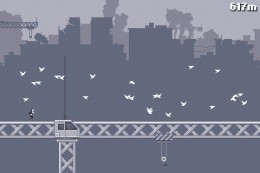 Ah, the eve of a big Apple keynote.
Ah, the eve of a big Apple keynote.
We’re guessing that you’re aware of the rumors by now, but just in case: word is that, tomorrow, at the Apple event, the company will announce two new products. One will be a taller iPhone. The other a smaller iPad dubbed iPad mini.
Like most people, we don’t know what Apple is going to show off. But, let’s pretend for a moment that both of these predictions are accurate. This means that in the near future two new devices with new screen sizes are going to be introduced to the market.
Our guts say that this isn’t going to be a big deal for game makers, but we wanted to ask just to make sure. Earlier today, we posed the following two question to a group of some of the hippest developers out there, hoping to learn what hurdles they’ll have to jump over, on an interface level, as they ready new and old games for the possible new devices.
If the rumors are true and the iPhone’s aspect ratio is changing to be taller (or wider in landscape mode), how is this going to change how you design game interfaces?
Similarly, if the iPad mini is an actual, real thing, how are you going to approach that?
The answers are telling. No-one is out of their mind worried about the upcoming changes, but there are some concerns with the normal stuff, like say, processors. Let’s dive into it.
 Simon Flesser, Simogo: “I think a lot of people underestimate how much work it is to design a game that operates in different aspect ratios, especially for 2D games in which the players have to control the scroll themselves by moving the character. In some cases it’s nearly impossible. That is why you see Nintendo locking their 2D games in an aspect ratio, New Super Mario Brothers Wii was 16:9 only and Wario Land for the same console was 4:3, and they added borders. You always have to be sure what the players can and cannot see, especially in platform games.
Simon Flesser, Simogo: “I think a lot of people underestimate how much work it is to design a game that operates in different aspect ratios, especially for 2D games in which the players have to control the scroll themselves by moving the character. In some cases it’s nearly impossible. That is why you see Nintendo locking their 2D games in an aspect ratio, New Super Mario Brothers Wii was 16:9 only and Wario Land for the same console was 4:3, and they added borders. You always have to be sure what the players can and cannot see, especially in platform games.
It is easier in autoscrollers like Bumpy Road though, because in these games the developer is in full control of what the player can and cannot see at any given time. For one-screen 2D games it is obviously the same case, but we still feel that it’s important to fill that extra space with something valuable. In Beat Sneak Bandit the gameplay area is the same on all platforms, but for iPad we made brick walls that I actually think adds a bit to the visuals.
 We actually thought a lot about that when starting to work on Year Walk. We’ve chosen to go with our own letterboxed aspect ratio. It is mainly to give it its own unique, very cinematic, look, but it solves a lot of problems for us too.
We actually thought a lot about that when starting to work on Year Walk. We’ve chosen to go with our own letterboxed aspect ratio. It is mainly to give it its own unique, very cinematic, look, but it solves a lot of problems for us too.
When it comes to the iPad mini it’s a little easier, since it’s the same aspect ratio — but we’ll have to be careful there again. Again, it’s really underestimated how much thinking there goes in to making visuals that works both on small and big screens. When designing for small screens, all the details need to be really clear (often you have to make stuff a lot bigger to make sure they are visible), characters need to be expressive, text often needs to be a lot larger. It still has to look good when blown up to the iPad. And now we have a third size to think about! So a challenge, but not as big as the potential aspect ratio change.
Also, something that feels like a gentle little swipe on small screens does not always feel as good on the iPad, and vice versa and now we have one more size to consider.
So to sum it up: Yeah, cool to have our games run on new fancy devices, but a change of aspect ratio is definitely the worst case scenario for a game designer."
![]() Jonas Wills, Phobic Studios: “We’re already looking at making our games support flexible aspect ratios for Android, so it doesn’t change much.
Jonas Wills, Phobic Studios: “We’re already looking at making our games support flexible aspect ratios for Android, so it doesn’t change much.
 Adam Saltsman, Semi-Secret Software: “I guess interface design is almost the least of my worries. We already have two different aspect ratios to support, so we need some flexibility there already. Having more is a bit of a hassle, but not a huge impediment to development.
Adam Saltsman, Semi-Secret Software: “I guess interface design is almost the least of my worries. We already have two different aspect ratios to support, so we need some flexibility there already. Having more is a bit of a hassle, but not a huge impediment to development.
Something we’re running into with Hundreds is it was originally a very iPad specific game, like, across the whole game itself, not just the interface (although you COULD argue that Hundreds is nothing but interface etc) so we actually have to manually customize and tweak a lot of the levels to … “localize" properly to the iPhone ratio a lot of interface stuff. I feel like it can be generalized into a formula you know — like “this goes in the corner here, this element stretches, etc," but when your games are designed around a specific idiom or metaphor or whatever, then these different aspect ratios can have a pretty big impact but THAT isn’t the biggest worry I have either.
 The main thing is there will be more powerful devices out, which means the new OS will require more power, which means players on older devices that upgrade will have a bit less power available for their games. Keeping our stuff running 60fps on an iPad 1 is already pretty difficult. A lot of games are just dropping support for [the original] iPad, but since its an ARM7 device there’s no way we can prevent iPad 1 owners from buying a game through the App Store that really won’t be optimal.
The main thing is there will be more powerful devices out, which means the new OS will require more power, which means players on older devices that upgrade will have a bit less power available for their games. Keeping our stuff running 60fps on an iPad 1 is already pretty difficult. A lot of games are just dropping support for [the original] iPad, but since its an ARM7 device there’s no way we can prevent iPad 1 owners from buying a game through the App Store that really won’t be optimal.
The upside to new hardware is a new bump in the audience size, and people revisiting the “classic" games, which is always nice when your games are sometimes on those lists, especially Bit Blot’s Aquaria, which we published, which is just ridiculously pretty on new screens."
 Keith Shepard, Imangi Studios: “I’m looking forward to whatever apple announces tomorrow. I’m excited about the potential for a slight taller iPhone or a new smaller iPad."
Keith Shepard, Imangi Studios: “I’m looking forward to whatever apple announces tomorrow. I’m excited about the potential for a slight taller iPhone or a new smaller iPad."
 Lee Petty, Art Director, Double Fine: “At Double Fine, we’re used to shipping games on a wide variety of platforms with different aspect ratios and resolutions. As much as possible, we try and create our game’s visuals at the highest resolution possible with an eye towards how our games will work on lower end platforms. With Double Fine Adventure, for example, we are authoring all of our art at 2048×1536 (a 4:3 aspect ratio and the iPad 3 retina resolution), but have several guidelines and templates that we can display directly on the game to make sure that everything works equally well with other aspect ratios and resolutions (such as 16:9, the rumored iPhone 5 aspect ratio).
Lee Petty, Art Director, Double Fine: “At Double Fine, we’re used to shipping games on a wide variety of platforms with different aspect ratios and resolutions. As much as possible, we try and create our game’s visuals at the highest resolution possible with an eye towards how our games will work on lower end platforms. With Double Fine Adventure, for example, we are authoring all of our art at 2048×1536 (a 4:3 aspect ratio and the iPad 3 retina resolution), but have several guidelines and templates that we can display directly on the game to make sure that everything works equally well with other aspect ratios and resolutions (such as 16:9, the rumored iPhone 5 aspect ratio).
Most of the cropping/downsampling of the art assets is handled in our build pipeline for the various platforms, but some of the UI requires different layout data so that the elements can be placed and scaled to be more appropriate for a particular platform.
As new devices are released, we should be able to adapt our current tools to support new aspect ratios and resolutions with relative ease."